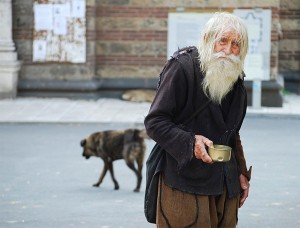
To hear the Russian pro-Kremlin media and government officials talk, one would think that things are improving in the country. In January, Russia’s Central bank head Elvira Nabiullina declared that the ruble’s dependence on oil prices was decreasing. Experts, however, believe otherwise. Prime Minister Dmitri Medvedev expects 2016 to become a year of economic growth. One is almost tempted to say that things are indeed improving and the crisis is over. However, official estimates suggest the opposite, and unlike the ruling elite, which is able to more or less adapt to a dire economic situation, the population is only now beginning to realize what a difficult time the country is facing. The population is getting poorer by the day.
As it became known on March 21, in 2015, the number of Russians living below the poverty line increased by 3.1 million, reaching 19.2 million people, which is the highest level since 2006. It has to be noted that these are official numbers. In 2015, income of 13.4 percent of Russians fell below the subsistence minimum established by the government. Given the fact that the subsistence minimum in the fourth quarter of 2015 amounted to mere 9,452 rubles a month ($115-145 depending on the ruble’s exchange rate that has been experiencing fluctuations throughout 2015) it becomes clear that the number of people living in poverty has increased considerably. It is worth mentioning that in the fourth quarter of 2015, the Russian Ministry of Labor and Social Protection lobbied for a reduction of the subsistence minimum explaining it by a reduction in the cost of food. This initiative caused an uproar. The subsistence minimum is an indicator that is officially used to determine the number of people living in poverty. It seems that the government decided to fight poverty by lowering its threshold.
Russians have been experiencing more than two years of continuous income decrease. According to a recent statement by Russia’s Economic Development Minister Alexei Uluykayev, who is known for avoiding ruffling the feathers of his superiors, it will take the country four years to come out of recession. In reality, the situation is much worse. All key economy rankings – the Consumer Confidence Index published by the Russian Statistics Service, the Sberbank Financial Mood Index that is overseen by the Levada Center, and the Social Sentiment Index prepared by the Lavada Center – are currently at their near-historic lows, said Mikhail Dmitriyev, president of the New Economic Growth Partnership, who predicted the 2011 and 2012 mass protests, in his interview to Slon. Also quite revealing is the fact that the Russian Federal Protective Service (FSO), whose main objective is to ensure the safety of top public officials, carries out its own, restricted public sentiment surveys. According to a FSO report that was leaked to the media last fall, almost 60 percent of residents of Russian monotowns view the social and economic situation in the country as unacceptable.
Russians are forced to spend a considerable part of their incomes on food while denying themselves every luxury. Thus, credit/debit cardholders spend 30 percent of their budgets on food, whereas overall in Russia, food accounts for 60 to 70 percent of households’ incomes. According to a VTsIOM survey, conducted in February 2016, 55 percent of respondents declared that they were personally affected by the crisis (for comparison, in November 2015, 45 percent of those surveyed believed themselves affected by the crisis). 16 percent of respondents said their wages had been cut down, and 12 percent said their wages were being held back. Alexander Demidov, general director of the International Institute of Marketing Researches, believes that this means that the income of almost one third of the Russian population has decreased dramatically.
Meanwhile, a survey conducted by the research holding Romir showed that 73 percent of Russian households have no precautionary savings, and 12 percent of those families have recently spend all their previously saved money. Another 10 percent of Russians are currently living on their savings.

The most astonishing thing about this situation, however, is that people actually believe that the government has a solution to the present crisis. The government does have a solution, and it is quite simple. The Russian Ministry of Economic Development expects a gradual increase in oil prices from $40 per barrel this year to $50 in 2018. “What if…not?” a well-known Russian singer Semyon Slepakov asks in his usual straightforward manner. Debts, poverty, lack of savings, scanty pensions – such is the result of the greedy actions of the Russian elite that refused to carry out reforms during those prosperous years when oil prices exceeded $100 per barrel. The day will come when people will stop believing in miracles, and then no Panama will save Putin’s thieving gang.





